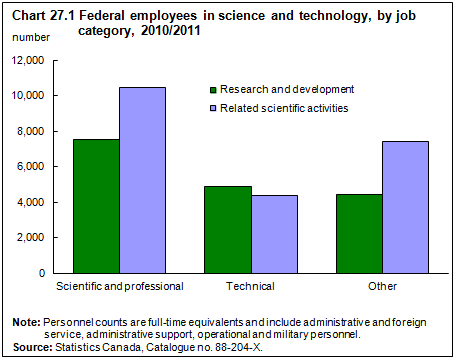Science and technology
Archived Content
Information identified as archived is provided for reference, research or recordkeeping purposes. It is not subject to the Government of Canada Web Standards and has not been altered or updated since it was archived. Please "contact us" to request a format other than those available.
Related information
Ongoing innovation and progress are essential to Canada's achievements in fast-moving science and technology (S&T) activities. Scientists and engineers are continuously searching for the knowledge and abilities that will help solve the increasingly complex problems we encounter in many areas of life. Several sectors in Canada—including governments, universities, hospitals, businesses, non-profit organizations and foreign entities—take an active role in funding these S&T activities.
In 2010/2011, the government anticipated spending $11.7 billion on S&T, up from the $11.3 billion planned for 2009/2010 and the $10.6 billion spent in 2008/2009. Of this $11.7 billion, $5.9 billion was dedicated to the S&T performance of federal departments and agencies, while $5.8 billion went to universities, businesses, non-profit organizations and other entities.
S&T activities
The majority of S&T work is what most Canadians imagine—scientists running tests in labs or engineers developing prototypes in research facilities. This is known as research and development (R&D). However, a large portion of S&T work falls under the category of related scientific activities. This includes data collection, information services, special studies, education support and administration. An anticipated $7.4 billion (64%) of the federal government's 2010/2011 S&T funding was designated for R&D, while the remaining $4.3 billion was for related scientific activities.
Businesses are the other major performer of R&D activities, with anticipated spending of $14.8 billion in 2010. Of this amount, 43% is expected to be split among five industries: scientific R&D services ($1.6 billion), communications equipment ($1.3 billion), wholesale trade ($1.2 billion), computer system design and related services ($1.1 billion), and information and culture ($1.1 billion). In 2008, the majority (79%) of industrial R&D funding came from the businesses active in R&D themselves, with 13% coming from foreign sources, 2% from the federal government, and the remaining 6% from other Canadian sources.
How much a country spends on R&D in a given year from all funding sources is called its gross domestic expenditures on research and development (GERD). Canada's GERD in 2010 totalled $29.2 billion. The Organisation for Economic Cooperation and Development (OECD) tracks GERD amounts from its member countries, with 2008 being the most recent year available. In 2008, Canada had a GERD of 1.8% of our GDP, placing us below the OECD average of 2.3%.
S&T objectives
Federal S&T expenditures are classified into socioeconomic objectives. This is a way to track trends and spending across different areas, such as health, industry, agriculture, energy, space and defence.
The objective receiving the highest overall government S&T spending in 2008/2009 was protection and improvement of human health, at $2.2 billion. The objectives receiving the most R&D spending were protection and improvement of human health ($1.6 billion), industrial protection and technology ($1.0 billion) and non-oriented research ($754 million).
The most notable changes in socio-economic categories from 2006/2007 to 2008/2009 were an increase in R&D spending for production, distribution and rational use of energy (36%); transport (33%); social structures and relationships (26%); and protection and improvement of human health (20%). Only fishing saw a large decrease (58%) in R&D spending.
S&T personnel
In 2010/2011, the total number of full-time equivalent employees working for the federal government in S&T roles is expected to reach 39,182. This is an almost 9% increase from the 36,027 S&T personnel employed in 2006/2007. Nearly half (46%) of the 2010/2011 employees are classified as scientific and professional (18,028), while the others are divided between technical roles (9,280) and those engaged in support activities (11,874).
Federal government S&T activities are available for natural sciences and engineering and for social sciences and humanities. Seven in 10 federal S&T employees work in natural sciences and engineering and the rest work in social sciences and humanities. These ratios have held steady since 2007/2008 and align with anticipated federal funding in 2010/2011: $8.7 billion directed at natural sciences and engineering and $2.9 billion for social sciences and humanities.
- Date modified:

